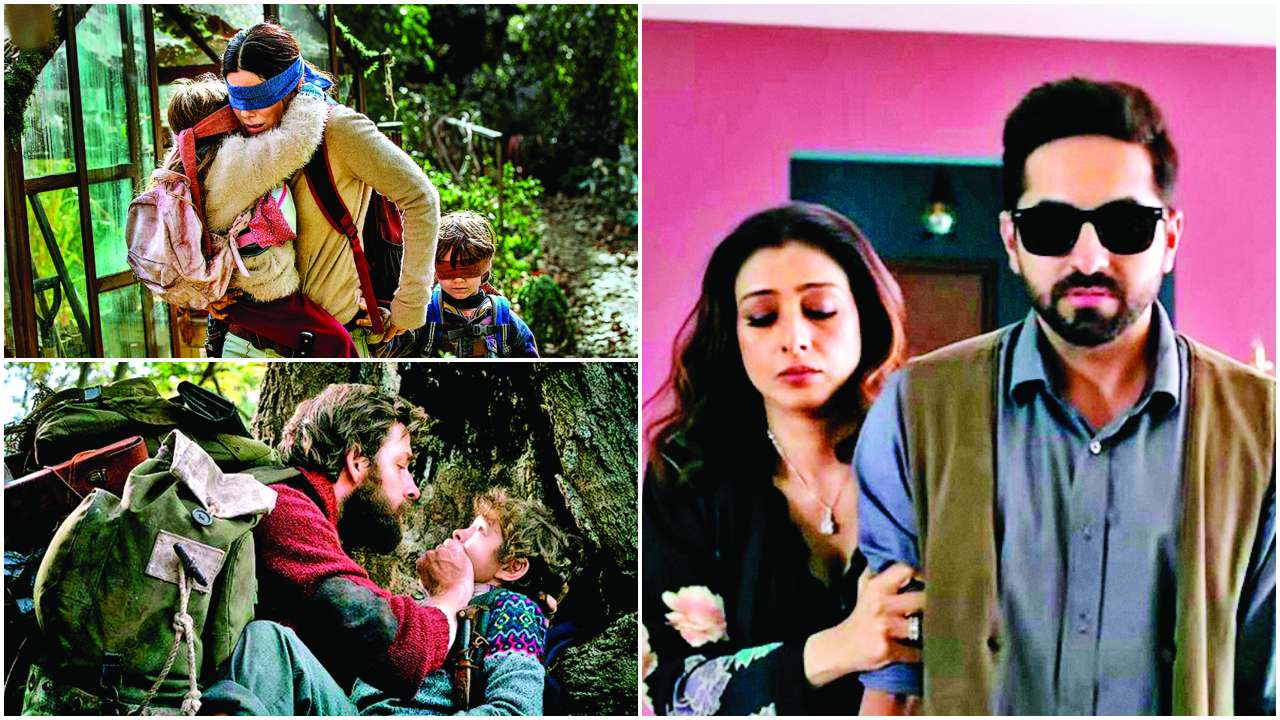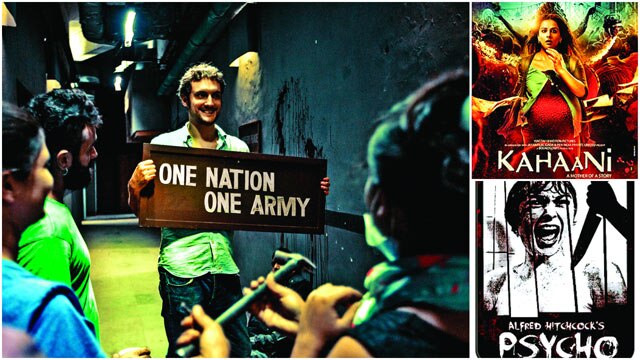
If one were to take a look at IMDB’s most awaited feature films for 2019, the first one to pop up is Velvet Buzzsaw – a horror/thriller movie about a supernatural force seeking revenge on those who have allowed greed to take precedence over art. A search for “most anticipated thrillers” throws up 20 options! But for Vish Dhamija, 48, author of recently-published The Heist Artist, there weren’t a gamut of thriller authors back in his day. Growing up reading foreign authors like Jeffrey Archer, Sherlock Holmes, Agatha Christie, Hardy Boys and Tintin series, he says, “There were few thriller writers other than Surendra Mohan Pathak, who wrote 500 pocket books and is now getting his novels translated to English.” Though the genre is as old as time, Dhamija points out, “it’s the narrative that’s changing.”
Netflix’s buzziest production, Bird Box’s premise is staying focused in a world that’s voluntarily going blind. Even two months after its release, there is a craze around the movie, whose name has little to do with the plot. People took up the Bird Box challenge, where teens, toddlers and grown-ups blindfolded themselves and their dogs, before going about their daily routine. Over 45,000 (and counting) posts have been listed under the hashtag on Instagram, and the numbers keep pouring in despite a warning about its dangers by Netflix.
Bird Box is set in a post-apocalyptic world, where a mother, played by Sandra Bullock, fights blindfolded to keep herself and her two kids alive from paranormal entities whose visions make people suicidal. In the last two years, the world was privy to a swarm of similar post-apocalyptic thrillers like Don’t Breathe, which had a blind antagonist; A Quiet Place, where the monsters are attracted to the slightest whispers; and Hush that has a deaf protagonist being chased in her own home by a serial killer. Closer home, movies like Andhadhun – with a blind hero and plot twists with every minute – cut the mustard. The trend here being: thrillers that impair one of the five human senses, bringing an urgency and a need to prompt the on-screen actors from the audience. “I saw A Quiet Place in the cinema and didn’t dare munch popcorn or even cough,” says Andhadhun writer-director Sriram Raghavan, 56, whose old favourite in the genre is Wait Until Dark (1967) by Terence Young, which had a blind protagonist being chased by a trio of thugs.
Explaining the trend, Patrick Graham, Director of Netflix thriller-horror series Ghoul says, “Sense deprivation is a fear for us all, but also, in the case of blindness, something that can heighten other senses to maximum dramatic effect.” He adds, “India’s own Andhadhun is what I found extremely enjoyable.”
However, Dhamija traces the remnants of this trend back to mid ’80s India with the movie Qatl. “The blind protagonist, played by Sanjeev Kumar, who literally counts the steps he takes to murder his wife, played by Sarika, has a similar concept. Thriller crime fiction has always been the second bestselling genre worldwide, after romance. Now the genre is not evolving but only trying to find its position in India.”

(Clockwise - Posters of Fede Álvarez’s Don’t Breathe; Rajiv Rai’s Gupt; RK Nayyar’s Qatl; Raji Rai's Yudh; Alfred Hitchcock’s 39 Steps; Mike Flanagan’s Hush)
For decades, thrillers were saddled with repetitive storylines and overplayed scare tactics, through little fault of the scriptwriters says Graham, who tried to spice it up with different horrors in each episode of Ghoul. However, 63-year-old film director, producer Rajiv Rai laments that it’s the audiences of today that “want something new everyday”. After his debut in 1985 with the thriller Yudh, Rai went on to direct blockbusters like Gupt (1997) and Mohra (1994). “In the ’80s, cinema and the audience were very different, tastes were different and making a film was very different. Thrillers needed action. Movies were made for one audience and we didn’t have to worry about catering to multiple tastes. Every movie had songs, commercial elements like comedy, emotions, or drama,” says Rai.
From changing scare tactics to changing technology, thrillers have done much to make the cut (no pun intended). And yet today there’s more emphasis on technique. “It’s all about making scenes look good, which digital can and cannot do as well,” Rai begins on how the reels have changed over decades. “It was never a ‘quick shoot’ in the earlier days. For instance, if you were working with negatives, you needed more light and the focus was always a delicate affair. With technology coming in, even a small kid can make a film,” he says with a smirk.
Though the veteran film director says he never follows a formula, Graham believes there are few “truly decent horror series that aren’t anthologies”. The reason for this, he explains, “It’s a hard genre to stretch out over a prolonged story. By the very nature of how they operate, horror stories can become deadening and repetitive over a longer run-time, hence successful examples of horror series, for example Haunting of Hill House, have made sure to change up the types of scares and supernatural threats from episode to episode.”
In the era of alien invasion and a series of sense-deprivation movies, how is the trend set? Unsure of how the genre zeitgeist evolves, Graham says, “I suspect it changes when a really good story comes to the fore. The zombie genre was absolutely dead for a couple of decades, and then 28 Days Later by Danny Boyle turned up and reignited it. We are still seeing the effects of that today with Walking Dead and World War Z”. He elaborates that these are fitting in this day and age of global, political and environmental turmoil, “where it seems like we are crying out for SOMEONE, ANYONE to help us.”

(Director Patrick Graham poses on the sets of the horror series Ghoul; posters of Sujoy Ghosh's Kahaani and Alfred Hitchcock's Psycho)
“What makes Fritz Lang’s M (1931) a great thriller? What makes Alfred Hitchcock’s The 39 Steps so exciting? Great scripts, great characters, an ability to build up a great scene of suspense, layer upon layer,” says 35-year-old Graham. Living in Mumbai for 10 years now, he’s always liked ghost stories. “I liked getting scared and scaring people from early days.” He now loves the challenge of thinking of ways to build a good scene of suspense. “I feel it is getting increasingly harder to capture that feeling of excitement when you’re really caught up in a film, but when it happens, it’s so satisfying. I just want to give an audience an entertaining thrill-ride,” he exclaims. However, even as he notes that the older audiences might be harder to impress, it’s the younger ones that “challenge filmmakers to do something different”.
Raghavan, on the other hand says, “All age groups are tough to please. My mom and my youngest nephew alike.” The drawback, however, of Indian thrillers is perhaps its repetitive nature. “Most subjects have a déjà vu quality. We are not breaking out in terms of ideas and stories. This is easy to say, but tougher to do. We need rigour in writing,” he adds.
So, what’s next for the genre? “Interactive stories, virtual reality or a low budget thriller by a new director that makes 200 crores,” reveals Raghavan, adding, “There’ll be enough to surprise us all.” From Graham – who believes the style of filmmaking has changed but the ingredients of a good thriller will always remain the same – we can expect “more high-concept, India-based horror... Stay tuned.”